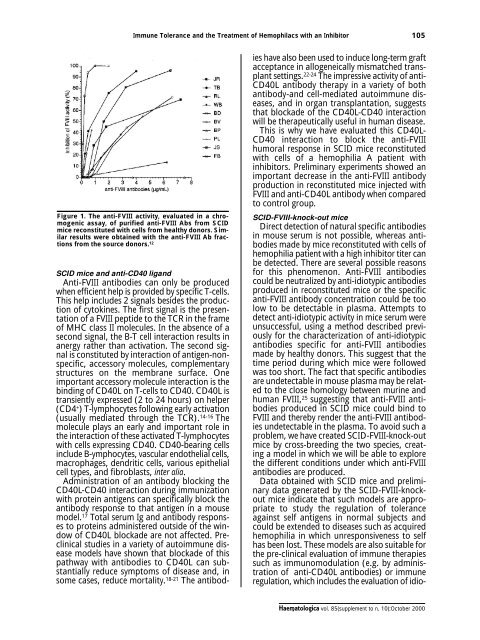Haematologica 2000;85:supplement to no. 10 - Supplements ...
Haematologica 2000;85:supplement to no. 10 - Supplements ...
Haematologica 2000;85:supplement to no. 10 - Supplements ...
Create successful ePaper yourself
Turn your PDF publications into a flip-book with our unique Google optimized e-Paper software.
Immune Tolerance and the Treatment of Hemophilacs with an Inhibi<strong>to</strong>r <strong>10</strong>5<br />
Figure 1. The anti-FVIII activity, evaluated in a chromogenic<br />
assay, of purified anti-FVIII Abs from SCID<br />
mice reconstituted with cells from healthy do<strong>no</strong>rs. Similar<br />
results were obtained with the anti-FVIII Ab fractions<br />
from the source do<strong>no</strong>rs. 12<br />
SCID mice and anti-CD40 ligand<br />
Anti-FVIII antibodies can only be produced<br />
when efficient help is provided by specific T-cells.<br />
This help includes 2 signals besides the production<br />
of cy<strong>to</strong>kines. The first signal is the presentation<br />
of a FVIII peptide <strong>to</strong> the TCR in the frame<br />
of MHC class II molecules. In the absence of a<br />
second signal, the B-T cell interaction results in<br />
anergy rather than activation. The second signal<br />
is constituted by interaction of antigen-<strong>no</strong>nspecific,<br />
accessory molecules, complementary<br />
structures on the membrane surface. One<br />
important accessory molecule interaction is the<br />
binding of CD40L on T-cells <strong>to</strong> CD40. CD40L is<br />
transiently expressed (2 <strong>to</strong> 24 hours) on helper<br />
(CD4 + ) T-lymphocytes following early activation<br />
(usually mediated through the TCR). 14-16 The<br />
molecule plays an early and important role in<br />
the interaction of these activated T-lymphocytes<br />
with cells expressing CD40. CD40-bearing cells<br />
include B-ymphocytes, vascular endothelial cells,<br />
macrophages, dendritic cells, various epithelial<br />
cell types, and fibroblasts, inter alia.<br />
Administration of an antibody blocking the<br />
CD40L-CD40 interaction during immunization<br />
with protein antigens can specifically block the<br />
antibody response <strong>to</strong> that antigen in a mouse<br />
model. 17 Total serum Ig and antibody responses<br />
<strong>to</strong> proteins administered outside of the window<br />
of CD40L blockade are <strong>no</strong>t affected. Preclinical<br />
studies in a variety of au<strong>to</strong>immune disease<br />
models have shown that blockade of this<br />
pathway with antibodies <strong>to</strong> CD40L can substantially<br />
reduce symp<strong>to</strong>ms of disease and, in<br />
some cases, reduce mortality. 18-21 The antibodies<br />
have also been used <strong>to</strong> induce long-term graft<br />
acceptance in allogeneically mismatched transplant<br />
settings. 22-24 The impressive activity of anti-<br />
CD40L antibody therapy in a variety of both<br />
antibody-and cell-mediated au<strong>to</strong>immune diseases,<br />
and in organ transplantation, suggests<br />
that blockade of the CD40L-CD40 interaction<br />
will be therapeutically useful in human disease.<br />
This is why we have evaluated this CD40L-<br />
CD40 interaction <strong>to</strong> block the anti-FVIII<br />
humoral response in SCID mice reconstituted<br />
with cells of a hemophilia A patient with<br />
inhibi<strong>to</strong>rs. Preliminary experiments showed an<br />
important decrease in the anti-FVIII antibody<br />
production in reconstituted mice injected with<br />
FVIII and anti-CD40L antibody when compared<br />
<strong>to</strong> control group.<br />
SCID-FVIII-k<strong>no</strong>ck-out mice<br />
Direct detection of natural specific antibodies<br />
in mouse serum is <strong>no</strong>t possible, whereas antibodies<br />
made by mice reconstituted with cells of<br />
hemophilia patient with a high inhibi<strong>to</strong>r titer can<br />
be detected. There are several possible reasons<br />
for this phe<strong>no</strong>me<strong>no</strong>n. Anti-FVIII antibodies<br />
could be neutralized by anti-idiotypic antibodies<br />
produced in reconstituted mice or the specific<br />
anti-FVIII antibody concentration could be <strong>to</strong>o<br />
low <strong>to</strong> be detectable in plasma. Attempts <strong>to</strong><br />
detect anti-idiotypic activity in mice serum were<br />
unsuccessful, using a method described previously<br />
for the characterization of anti-idiotypic<br />
antibodies specific for anti-FVIII antibodies<br />
made by healthy do<strong>no</strong>rs. This suggest that the<br />
time period during which mice were followed<br />
was <strong>to</strong>o short. The fact that specific antibodies<br />
are undetectable in mouse plasma may be related<br />
<strong>to</strong> the close homology between murine and<br />
human FVIII, 25 suggesting that anti-FVIII antibodies<br />
produced in SCID mice could bind <strong>to</strong><br />
FVIII and thereby render the anti-FVIII antibodies<br />
undetectable in the plasma. To avoid such a<br />
problem, we have created SCID-FVIII-k<strong>no</strong>ck-out<br />
mice by cross-breeding the two species, creating<br />
a model in which we will be able <strong>to</strong> explore<br />
the different conditions under which anti-FVIII<br />
antibodies are produced.<br />
Data obtained with SCID mice and preliminary<br />
data generated by the SCID-FVIII-k<strong>no</strong>ckout<br />
mice indicate that such models are appropriate<br />
<strong>to</strong> study the regulation of <strong>to</strong>lerance<br />
against self antigens in <strong>no</strong>rmal subjects and<br />
could be extended <strong>to</strong> diseases such as acquired<br />
hemophilia in which unresponsiveness <strong>to</strong> self<br />
has been lost. These models are also suitable for<br />
the pre-clinical evaluation of immune therapies<br />
such as immu<strong>no</strong>modulation (e.g. by administration<br />
of anti-CD40L antibodies) or immune<br />
regulation, which includes the evaluation of idio-<br />
<strong>Haema<strong>to</strong>logica</strong> vol. <strong>85</strong>(<strong>supplement</strong> <strong>to</strong> n. <strong>10</strong>):Oc<strong>to</strong>ber <strong>2000</strong>
















